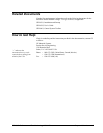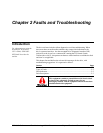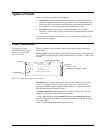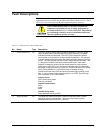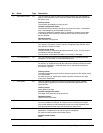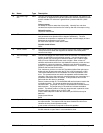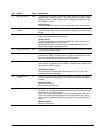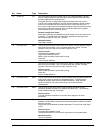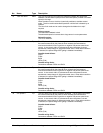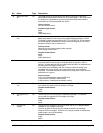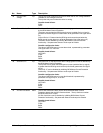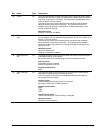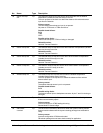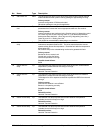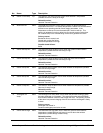
GEH-6385 Reference and Troubleshooting, 2300 V Drives Chapter 2 Faults and Troubleshooting
•
••
•
2-7
No. Name Type Description
24 Power dip Trip
The Power dip trip fault occurs when the DC link voltage feedback (variable
DC bus voltage) falls below the power dip level and remains below the power
dip level longer than the power dip time.
The power dip time is configurable through parameter Power dip control.
If the DC link voltage feedback is at some moments below the power dip level
and at some moments above the power dip level, the trip fault can occur. If
over any time interval the DC link feedback spends more time below the power
dip level than above the power dip level, and the time difference is greater
than the power dip time, Power dip occurs.
Possible configuration faults:
Power dip functionality is disabled because parameter Power dip control is set
incorrectly. To enable power dip functionality parameter Power dip control
should be set equal to 0.500 sec (Enable).
Related functions:
Power Dip Protection
25 Cur reg in limit
Alarm The Cur reg in limit alarm occurs when the X and/or Y current regulator output
enter limits for more than 1 sec. It is cleared when the X and/or Y current
regulator come out of limit for more than of equal to 1 sec.
Primary causes:
The tachometer feedback is bad.
Large motor parameters errors.
Motor inverter connection opens while running.
Power dip.
Loss of current feedback.
26 Volt reg in limit Alarm
The Volt reg in limit alarm occurs when the X and/or Y voltage regulator output
enter limits for more than 1 sec. It is cleared when the X and/or Y voltage
regulator come out of limit for more than of equal to 1 sec.
Primary causes:
Motor inverter connection opens while running.
Power dip.
Loss of voltage feedback.
28 R1 meas in limit Alarm
The R1 meas in limit alarm occurs when the total primary resistance measured
during drive pre-flux is outside of a reasonable bound. The total primary
resistance consists of the stator and cable resistances. When the fault
condition is present, the motor control does not use the resistance
measurement.
29 R2 meas in limit Alarm The R2 meas in limit alarm occurs when the online calculation of rotor
resistance exceeds the positive or negative saturation level. The saturation
levels are 80 percent and -40 percent.
Primary causes:
The rotor resistance calculation is incorrect due a large error in motor
parameters.
30 Tach loss trip Trip The Tach loss trip fault occurs when the difference between the tachometer
feedback (variable Motor speed) and the estimated speed (variable Calculated
speed) is too large.
The trip fault can be disabled by setting parameter Tach loss fault mode equal
to Trip.
Primary causes:
The tachometer feedback is bad.
The estimated speed is incorrect due to large errors in motor parameters.
Related functions:
Tach Loss Detection



